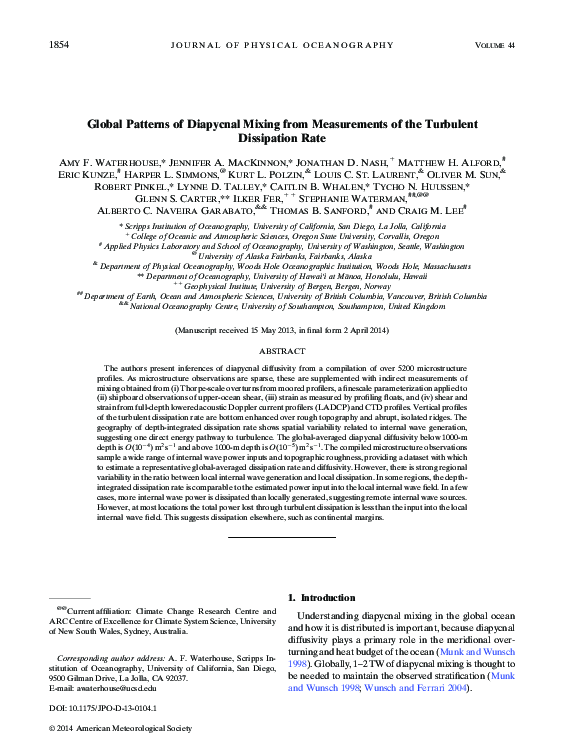Global patterns of diapycnal mixing from measurements of the turbulent dissipation rate
Waterhouse, A. F. and MacKinnon, J. A. and Nash, J. D. and Alford, M. H. and Kunze, E. and Simmons, H. L. and Polzin, K. L. and St. Laurent, L. C. and Sun, O. M. and Pinkel, R. and Talley, L. D. and Whalen, C. B. and Huussen, T. N. and Carter, G. and Fer, I. and Waterman, S. N. and Naveira Garabato, A. C. and Sanford, T. B. and Lee, C. M.
abstract: The authors present inferences of diapycnal diffusivity from a compilation of over 5200 microstructure profiles. As microstructure observations are sparse, these are supplemented with indirect measurements of mixing obtained from (i) Thorpe-scale overturns from moored profilers, a finescale parameterization applied to (ii) shipboard observations of upper-ocean shear, (iii) strain as measured by profiling floats, and (iv) shear and strain from full-depth lowered acoustic Doppler current profilers (LADCP) and CTD profiles. Vertical profiles of the turbulent dissipation rate are bottom enhanced over rough topography and abrupt, isolated ridges. The geography of depth-integrated dissipation rate shows spatial variability related to internal wave generation, suggesting one direct energy pathway to turbulence. The global-averaged diapycnal diffusivity below 1000-m depth is O(10^4) m^2 s^-1 and above 1000-m depth is O(10^5) m^2 s^-1. The compiled microstructure observations sample a wide range of internal wave power inputs and topographic roughness, providing a dataset with which to estimate a representative global-averaged dissipation rate and diffusivity. However, there is strong regional variability in the ratio between local internal wave generation and local dissipation. In some regions, the depth-integrated dissipation rate is comparable to the estimated power input into the local internal wave field. In a few cases, more internal wave power is dissipated than locally generated, suggesting remote internal wave sources. However, at most locations the total power lost through turbulent dissipation is less than the input into the local internal wave field. This suggests dissipation elsewhere, such as continental margins.
@article{Waterhouse-etal-2014,
author = {Waterhouse, A. F. and MacKinnon, J. A. and Nash, J. D. and Alford, M. H. and Kunze, E. and Simmons, H. L. and Polzin, K. L. and St.~Laurent, L. C. and Sun, O. M. and Pinkel, R. and Talley, L. D. and Whalen, C. B. and Huussen, T. N. and Carter, G. and Fer, I. and Waterman, S. N. and Naveira~Garabato, A. C. and Sanford, T. B. and Lee, C. M.},
title = {Global patterns of diapycnal mixing from measurements of the turbulent dissipation rate},
journal = {J. Phys. Ocean.},
year = {2014},
pages = {1854--1872},
volume = {44},
issue = {7},
doi = {10.1175/JPO-D-13-0104.1},
url = {https://eprints.soton.ac.uk/367963/}
}
